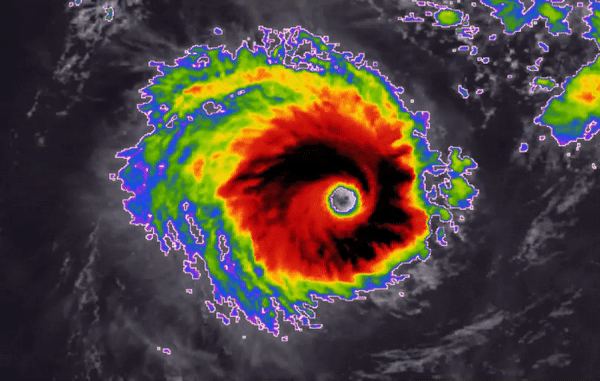Formidable Cyclone Freddy, taking an unusual track, sets sights on Madagascar
Powerful Tropical Cyclone Freddy, a long-lived storm that was churning westward across the Indian Ocean on Saturday more than a week after forming near Indonesia, is expected to continue taking an unusual track toward Madagascar next week, according to AccuWeather forecasters.
The path that the cyclone is taking across the Indian Ocean has happened only two other times in the tropical basin's recorded history. The most recent time that a storm took such a track was in 2000. Freddy is currently on a path to slam into Madagascar around Tuesday of next week, and the storm will threaten the island nation with high winds, torrential rains and rough seas when it makes its approach.
The warning comes just days after another strong tropical cyclone in the Southern Hemisphere made headlines. Cyclone Gabrielle brought severe flooding to northern New Zealand this past weekend and earlier this week, displacing thousands and leaving at least eight dead, according to The Associated Press.
 |
The historical track, current position and satellite and forecast EyePath™ of Freddy, as seen on AccuWeather's Hurricane Tracker on Saturday afternoon, local time. |
As of Saturday afternoon, local time, Freddy was churning several hundred miles east of Madagascar and was categorized as an "intense" tropical cyclone by Meteo France La Reunion, the government agency responsible for tracking storms in this part of the world. It was estimated that the cyclone's maximum sustained winds were about 115 mph (about 185 km/h), with gusts to about 161 mph (about 260 km/h). Those sustained winds are equivalent to a Category 3 major hurricane on the Saffir-Simpson Hurricane Wind Scale.
This is not the strongest that the storm has been throughout its lifespan. On Wednesday, Freddy had estimated maximum sustained winds of 133 mph (about 214 km/h).
 |
AccuWeather RealVue(tm) Satellite shows Cyclone Freddy swirling in the Indian Ocean Friday. |
Freddy first formed on Monday, Feb. 6, in the far eastern Indian Ocean to the south of Indonesia. It was one of three cyclones that were spinning simultaneously in the oceans around Australia last week and is the only one remaining; the others were Gabrielle and Dingani.
"Only two other cyclones have taken a track from the eastern Indian Ocean to near Madagascar, and they were Hudah, and Leone, also known as Eline, in 2000," said AccuWeather Lead International Forecaster Jason Nicholls. "Coincidentally, the year 2000 was also the last time there was a 'triple-dip La Niña.'"
A "triple-dip La Niña" means that it is the third year in a row that La Niña conditions were present in the waters of the equatorial Pacific Ocean. The La Niña teleconnection can have a global, outsized impact on how many tropical systems can form and where they ultimately track.
Madagascar, and the tiny, vulnerable Mascarene Islands to the east of the country, will likely have to contend with the effects of the powerful cyclone as Freddy approaches this week.
"Freddy should largely maintain its strength through the weekend, then it may lose some wind intensity on final approach to Madagascar around Tuesday," said Nicholls. "Despite that, it will still probably make landfall as the equivalent of a Category 3 or 4 hurricane." A Category 3 hurricane has maximum sustained winds of at least 111 mph (178 km/h).
While the exact track of Freddy prior to landfall, and where exactly it will come ashore, are still uncertain at this time, it appears likely that the country will sustain significant impacts. AccuWeather forecasters are warning that heavy rain, flooding and damaging winds will be possible in Madagascar from Tuesday through Thursday. Total rainfall from Freddy could exceed 12 inches (about 305 mm) over the mountainous terrain, and wind gusts as high as 160 mph (about 250 km/h) will be possible near the point of landfall.
 |
A house lays in ruins in Mananjary, Madagascar, Thursday, Feb. 10, 2022, in the aftermath of Cyclone Batsirai. (AP Photo/Viviene Rakotoarivony) |
Historically, this would put Freddy in some notable company. The strongest storm to strike the nation since reliable record-keeping began in the 1960s was Enawo in March 2017. That cyclone packed winds as high as 150 mph (about 240 km/h), equivalent to a Category 4 hurricane.
Freddy is already expected to be the strongest cyclone to threaten the nation since deadly Cyclone Batsirai ripped through the region in early February 2022. "Last season was a rough one for the country, with six landfalling storms over the span of just a month from January to February," added Nicholls.
More than two weeks after its initial formation, Freddy may still be a trackable tropical entity after impacting Madagascar, and meteorologists say that it could threaten Mozambique later in the week.
Correction: This article misstated the location of the the Mascarene Islands. The islands are located to the east of Madagascar, not to the north.
Want next-level safety, ad-free? Unlock advanced, hyperlocal severe weather alerts when you subscribe to Premium+ on the AccuWeather app. AccuWeather Alerts™ are prompted by our expert meteorologists who monitor and analyze dangerous weather risks 24/7 to keep you and your family safer.



